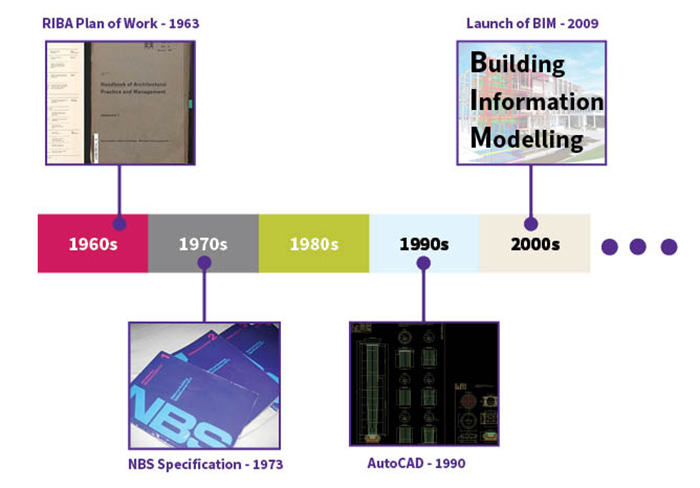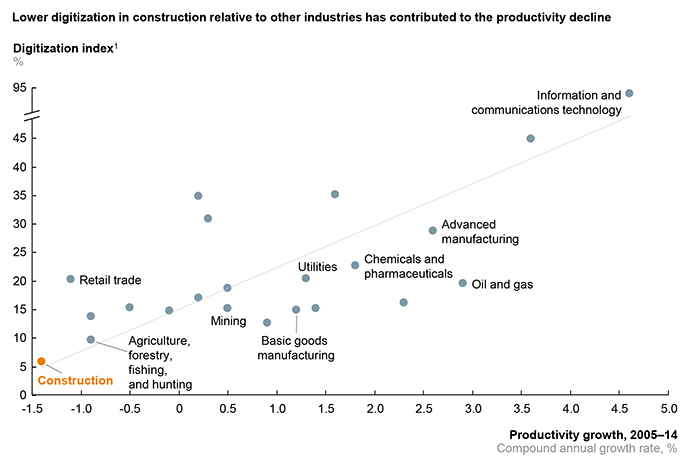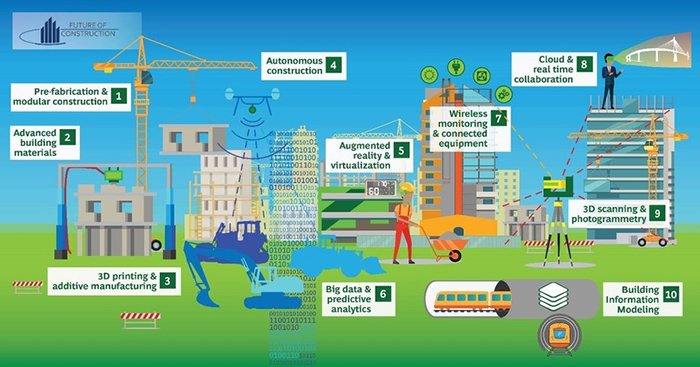In the last few years there has been an explosion of talk about digitising the construction industry, but what does it mean? In an industry which has been led by paper-based practices for a number of decades, as well as manual methods of working; ‘digitisation’ relates to the adoption of electronic techniques which can impact all aspects of the built environment.
 Some of the main disruptors of the construction industry’s working practices
In a recent webinar by the NBS, it presented that the construction industry is lagging behind and much is needed to be done; quite surprisingly even the Fisheries and Hunting sectors are ahead in digital practices. Yet there are so many reasons to get up to speed and many tools at our disposal.
Some of the main disruptors of the construction industry’s working practices
In a recent webinar by the NBS, it presented that the construction industry is lagging behind and much is needed to be done; quite surprisingly even the Fisheries and Hunting sectors are ahead in digital practices. Yet there are so many reasons to get up to speed and many tools at our disposal.
 Reinventing construction through a productivity revolution – McKinsey Global Institute (February 27, 2017 I Report)
The birth of the term IOT (Internet of Things) was coined in 1999 by Kevin Ashton during his time at Procter and Gamble; it is the joined-up connections of different devices, which is now progressing into the way the outputs of these can be shared – connecting us electronically and what insights can be garnered through them using ‘Big Data’. Although not exclusive to the built environment; there are a growing number of themes which sit under the umbrella of digital construction in relation to IOT.
BIM, Digital Twins and the Golden Thread are a few of these emerging processes, designed to help digitise the industry:
Reinventing construction through a productivity revolution – McKinsey Global Institute (February 27, 2017 I Report)
The birth of the term IOT (Internet of Things) was coined in 1999 by Kevin Ashton during his time at Procter and Gamble; it is the joined-up connections of different devices, which is now progressing into the way the outputs of these can be shared – connecting us electronically and what insights can be garnered through them using ‘Big Data’. Although not exclusive to the built environment; there are a growing number of themes which sit under the umbrella of digital construction in relation to IOT.
BIM, Digital Twins and the Golden Thread are a few of these emerging processes, designed to help digitise the industry:
 The Fourth Industrial Revolution is about to hit the construction industry Image: World Economic Forum, Boston Consulting Group - 2018
It will be interesting to see how the momentum builds in the ensuing year/s and the up-take of these practices, which in the long run should lead to better designed, built and managed buildings as well as improving efficiency and potentially reducing costs along the way. Hopefully, it won’t be long till the industry moves up the digitisation index and over-takes other industries as processes are finessed.
The Fourth Industrial Revolution is about to hit the construction industry Image: World Economic Forum, Boston Consulting Group - 2018
It will be interesting to see how the momentum builds in the ensuing year/s and the up-take of these practices, which in the long run should lead to better designed, built and managed buildings as well as improving efficiency and potentially reducing costs along the way. Hopefully, it won’t be long till the industry moves up the digitisation index and over-takes other industries as processes are finessed.
 Some of the main disruptors of the construction industry’s working practices
In a recent webinar by the NBS, it presented that the construction industry is lagging behind and much is needed to be done; quite surprisingly even the Fisheries and Hunting sectors are ahead in digital practices. Yet there are so many reasons to get up to speed and many tools at our disposal.
Some of the main disruptors of the construction industry’s working practices
In a recent webinar by the NBS, it presented that the construction industry is lagging behind and much is needed to be done; quite surprisingly even the Fisheries and Hunting sectors are ahead in digital practices. Yet there are so many reasons to get up to speed and many tools at our disposal.
 Reinventing construction through a productivity revolution – McKinsey Global Institute (February 27, 2017 I Report)
The birth of the term IOT (Internet of Things) was coined in 1999 by Kevin Ashton during his time at Procter and Gamble; it is the joined-up connections of different devices, which is now progressing into the way the outputs of these can be shared – connecting us electronically and what insights can be garnered through them using ‘Big Data’. Although not exclusive to the built environment; there are a growing number of themes which sit under the umbrella of digital construction in relation to IOT.
BIM, Digital Twins and the Golden Thread are a few of these emerging processes, designed to help digitise the industry:
Reinventing construction through a productivity revolution – McKinsey Global Institute (February 27, 2017 I Report)
The birth of the term IOT (Internet of Things) was coined in 1999 by Kevin Ashton during his time at Procter and Gamble; it is the joined-up connections of different devices, which is now progressing into the way the outputs of these can be shared – connecting us electronically and what insights can be garnered through them using ‘Big Data’. Although not exclusive to the built environment; there are a growing number of themes which sit under the umbrella of digital construction in relation to IOT.
BIM, Digital Twins and the Golden Thread are a few of these emerging processes, designed to help digitise the industry:
- BIM (Building Information Modelling) was launched in 2009, having been developed to manage and share data throughout a project’s life-cycle; from cradle to grave. As buildings are specified, 3D models can be constructed with imported data about every element of the products used to help with the building process, as well as maintenance of the building after hand-over
- Digital Twins concept has been around for a while but only recently taken the limelight in the construction industry. Still, at a fairly early stage of its adoption, the process involves creating a digital replica or model of an existing building. Sensors placed in the actual building provide the model with real in-use data which can be used to better predict the impact of building improvements or the future design of new buildings
- The Golden Thread, for construction, emanated from the Hackitt Report (2018) which in its simplest form ensures that the original design intent is defined, and any subsequent changes go through a formal review process by people competent to do so, ensuring a building is safe and fit for use. BIM and other collaborative tools become an essential part of the process, capturing the information and records in digital form which can be easily accessed by all
- More accountability for building specifications – safer buildings
- A better understanding of how our buildings are performing against sustainability goals in our drive for lower carbon emissions and Net Zero
- Improved risk management, particularly important as build projects are becoming larger and more complex
- Better data sharing practices
- A common data environment so all are singing off the same page
 The Fourth Industrial Revolution is about to hit the construction industry Image: World Economic Forum, Boston Consulting Group - 2018
It will be interesting to see how the momentum builds in the ensuing year/s and the up-take of these practices, which in the long run should lead to better designed, built and managed buildings as well as improving efficiency and potentially reducing costs along the way. Hopefully, it won’t be long till the industry moves up the digitisation index and over-takes other industries as processes are finessed.
The Fourth Industrial Revolution is about to hit the construction industry Image: World Economic Forum, Boston Consulting Group - 2018
It will be interesting to see how the momentum builds in the ensuing year/s and the up-take of these practices, which in the long run should lead to better designed, built and managed buildings as well as improving efficiency and potentially reducing costs along the way. Hopefully, it won’t be long till the industry moves up the digitisation index and over-takes other industries as processes are finessed.- Date
- Category
- The Built Environment